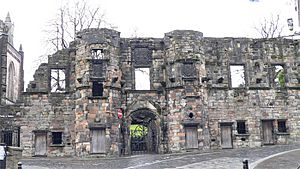Mar's Wark facts for kids
Quick facts for kids Mar's Wark |
|
|---|---|

East façade of Mar's Wark at the head of Broad Street
|
|
| Location | St John Street, Stirling, Scotland |
| Built | 1572 |
| Built for | John Erskine, Earl of Mar |
| Designated | 31 December 1921 |
| Reference no. | SM90289 |
| Lua error in Module:Location_map at line 420: attempt to index field 'wikibase' (a nil value). | |
Mar's Wark is a ruined building in Stirling, Scotland. It was built between 1570 and 1572. A powerful man named John Erskine, who was the Regent of Scotland (meaning he ruled the country for the young king) and the Earl of Mar, had it built.
Today, Historic Scotland looks after this historic site. John Erskine wanted Mar's Wark to be the main home for his family, the Clan Erskine, in Stirling. His family was also in charge of the nearby royal Stirling Castle, where the princes of Scotland were educated. The word Wark is an old Scottish word for "building." This house is also known as "Mar's Lodging."
What Mar's Wark Looks Like
The building faces the churchyard of the Holy Rude Church. It sits at the top of the main path that leads to Stirling Castle. This path is above the town's old tax office, called a tollbooth.
The front of the building, called the façade, still stands. It used to have an upper floor, but that part is now missing. You can still go inside to the first floor. The basement rooms have doors and windows facing the street. They might have been planned as shops long ago.
The front of Mar's Wark is almost the same on both sides. It has a main entrance area with two round towers. The building is decorated with many carved stones. These carvings were inspired by European art and designs. They show symbols of the royal family and the Erskine family. There are also some funny or clever sayings carved into the stone.
One special carving is the letter "A" with a crown. This might refer to a different way the Erskine family name was spelled, like "Areskine." Or it could be the first letter of Mar's wife's name, Annabella Murray. People traditionally believe that some of these carved stones were reused from an old church called Cambuskenneth Abbey.
The way Mar's Wark is built, with its shapes and decorations, is very similar to royal buildings. It especially looks like the palace at Stirling Castle. It's possible that the Earl of Mar hired the royal architect of that time, William MacDowall, to help build it. Today, the Scottish Government protects Mar's Wark as a scheduled monument. This means it's an important historical site.
Messages Carved in Stone
There are special messages carved into the main entrance of Mar's Wark. These messages are in an old Scottish language called Middle Scots. They are like the building itself speaking. They talk about how people should look at the building and how important the Regent was.
Here are the messages and what they mean:
- South tower
I pray all luikaris on this luging With gentile E to gif thair juging This means: I ask everyone looking at this building, with a kind eye, to give their opinion.
- North tower
The moir I stand on oppin hitht My faultis moir subject ar to sitht This means: The more I stand out in the open, the more my faults can be seen. (It's like saying: Because I am so grand and visible, any mistakes are more obvious.)
- Internal (exit) arch
Esspy speik furth and spair nocht Considder veil I cair notht This means: See, speak out and don't hold back. Consider it well, I don't care. (It's a bold statement, inviting people to judge it freely.)
History of Mar's Wark
Many people say that Mar's Wark was never fully finished. However, there isn't much proof for this idea. It was probably still being built when Regent Mar died in October 1572. Records from Stirling show that his wife, Countess Annabella, continued to use the building.
In April 1584, a group supporting the Earl of Angus was told to give up Stirling Castle and the town gates. They were also told to give up "the lodging of Annabell, Countess of Mar," and other strong places. Later, in May 1584, a prisoner named Earl of Gowrie was brought to "Lady Marrs House" for his trial.
In December 1593, Anne of Denmark, who was the Queen and pregnant with Prince Henry, came to Stirling. She first stayed in the Earl of Argyll's house. Then she moved to Lady Mar's lodging until her rooms in the castle were ready. In May 1595, a big dinner party was planned at the Countess of Mar's new house in Stirling. This was for the wedding of the king's friend, Anne Murray, and Lord Glamis.
In 1602, a French ambassador named the Baron de Tour visited Stirling. He had a conversation with the Countess in "Lady Mar's House." Because Mar's Wark overlooks Broad Street and the town, it was later used to place cannons during times of trouble. The building might have been used this way in May 1578. At that time, there was talk about holding a parliament in the tolbooth, and some old papers mention "Lady Maries House," which probably meant "Lady Mar's House."

